Chinese anti-tank artillery in the Sino-Japanese and Civil Wars
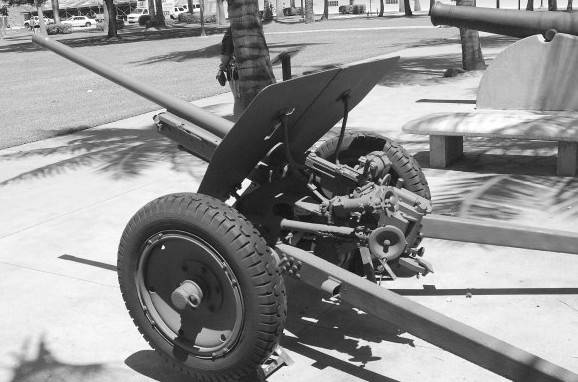
In the 1930s, China was an underdeveloped agricultural country. Economic and technological backwardness was aggravated by the fact that several warring factions fought for power in the country. Taking advantage of the weakness of the central government, unsatisfactory training and poor equipment of the Chinese armed forces, Japan decided to turn China into its raw material colony.
After the annexation of Manchuria by Japan and a number of armed provocations, the Japan-China War (Second Japan-China War) began in 1937. As early as December 1937, after the Japanese army captured Nanjing, the Chinese army lost most of its heavy weapons. In this regard, the leader of the Kuomintang Nationalist Party, Chiang Kai-shek, was forced to seek foreign support.
In 1937, the Chinese government asked the USSR for help in the fight against Japanese aggression. After the completion of the construction of the Sary-Ozek - Urumqi - Lanzhou highway, delivery from the USSR began weapons, equipment and ammunition. Soviet-made aircraft were mainly flown to Chinese airfields. To combat Japanese aggression, the Soviet Union provided China with a $ 250 million loan.
Cooperation between Moscow and the Chinese government in Nanjing continued until March 1942. About 5 Soviet citizens visited China: military advisers, pilots, doctors and technical specialists. From 000 to 1937, the USSR supplied the Kuomintang with 1941 aircraft, 1 artillery pieces, 285 light tank T-26, 14 thousand light and heavy machine guns, 1 cars and tractors.
In parallel with the USSR, the Kuomintang conducted military-technical cooperation with the United States, Great Britain and a number of European states. The United States made the greatest contribution to the fight against the Japanese. In 1941, China was subject to the Lend-Lease Act. After that, the Kuomintang began to receive large-scale military and logistical support.
In the 1930s, China worked closely with Germany. In exchange for raw materials, the Germans helped modernize the Chinese army by sending advisers, supplying small arms, artillery pieces, light tanks and aircraft. Germany helped with the construction of new and modernization of existing defense enterprises. So, with German support, the Hanyang arsenal was modernized, where the production of rifles and machine guns was carried out. In the vicinity of the city of Changsha, the Germans built an artillery plant, and in Nanjing, an enterprise for the production of binoculars and optical sights.
This situation persisted until 1938, when Berlin officially recognized the puppet state of Manchukuo, created by the Japanese in Manchuria.
The Chinese armed forces in the late 1930s and early 1940s were equipped with a motley mixture of equipment and weapons produced in Europe, America and the USSR. In addition, the Chinese army very actively used Japanese-made weapons captured in battles.
37-mm guns supplied from Germany and manufactured under license at Chinese enterprises
The first specialized anti-tank gun produced in China was the 37 mm Type 30.
This gun was a licensed version of the German 3,7 cm Pak 29 and was mass-produced at an artillery plant in Chansha. In total, about 200 37-mm Type 30 guns were assembled in China.
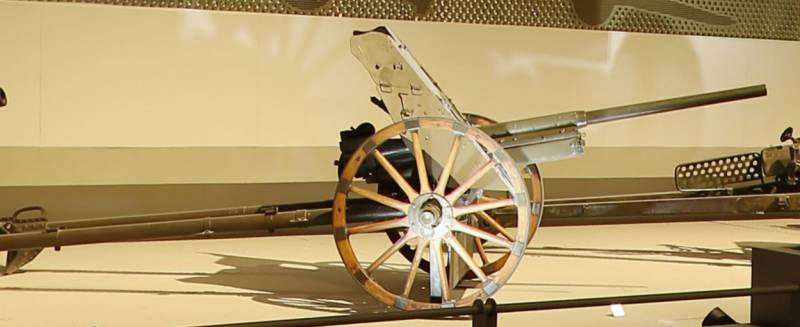
37-mm Type 30 anti-tank gun at the War Museum of the Chinese Revolution
The anti-tank gun 3,7 cm Pak 29, created by Rheinmetall AG in 1929, was a very advanced artillery system for its time, capable of striking all existing tanks at that time.
The mass of the Type 30 gun in the firing position was 450 kg. Combat rate of fire - up to 12-14 rds / min. An armor-piercing projectile with a mass of 0,685 g left the barrel with an initial speed of 745 m / s and at a distance of 500 m along the normal could overcome 35 mm armor.
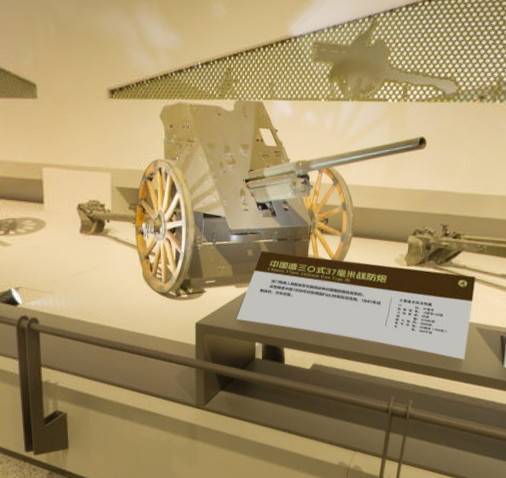
An archaic technical solution in the design of the 3,7 cm Pak 29 anti-tank gun was wooden wheels without suspension, which did not allow the use of mechanical traction for towing. Subsequently, the 37 mm cannon was modernized and put into service in Germany under the designation 3,7 cm Pak 35/36. The 3,7 cm Pak 29 and 3,7 cm Pak 35/36 guns used the same ammunition and mainly differed in wheel travel.
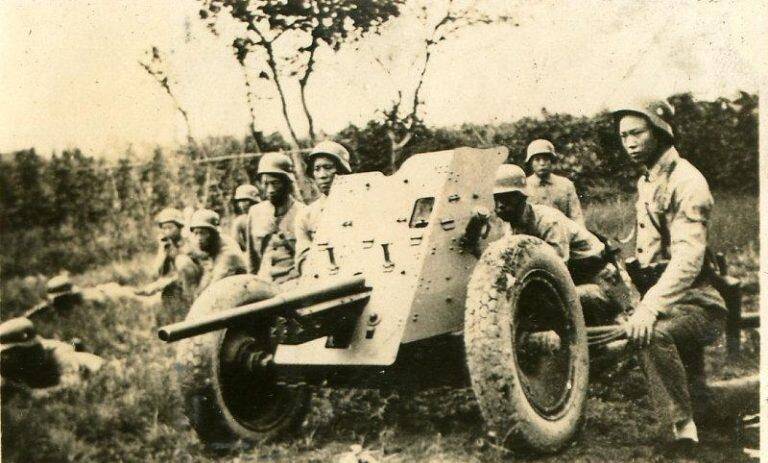
Chinese crew with 37-mm anti-tank gun 3,7 cm Pak 35/36
There is information that Germany supplied China with a number of 3,7 cm Pak 35/36 guns, which were also used in hostilities.
In the initial period of the war in China, the Imperial Japanese Army used Type 89 medium tanks (maximum armor thickness 17 mm), Type 92 light tanks (maximum armor thickness 6 mm), Type 95 light tanks (maximum armor thickness 12 mm) and Type 94 tankettes ( maximum armor thickness 12 mm). The armor of all these vehicles at real firing range could be easily penetrated by a 37 mm projectile fired from a Type 30 or Pak 35/36.
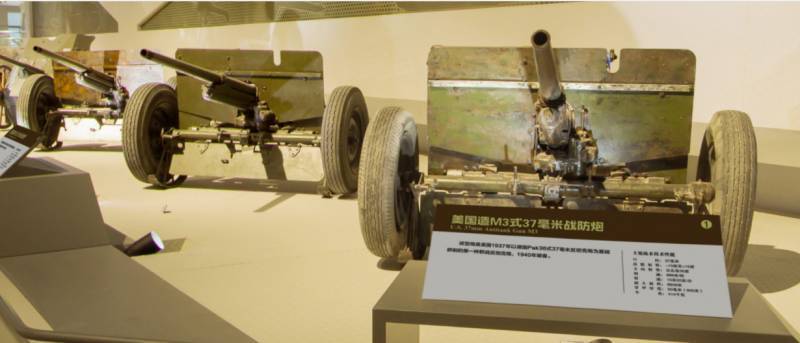
American 37-mm anti-tank guns M3A1 at the War Museum of the Chinese Revolution
After the curtailment of military-technical cooperation with Germany and the Soviet Union, the United States became the main supplier of anti-tank artillery to China. At the end of 1941, 37-mm M3A1 anti-tank guns appeared in the Chinese anti-tank units. It was a good weapon, not inferior to the German 3,7 cm Pak 35/36.
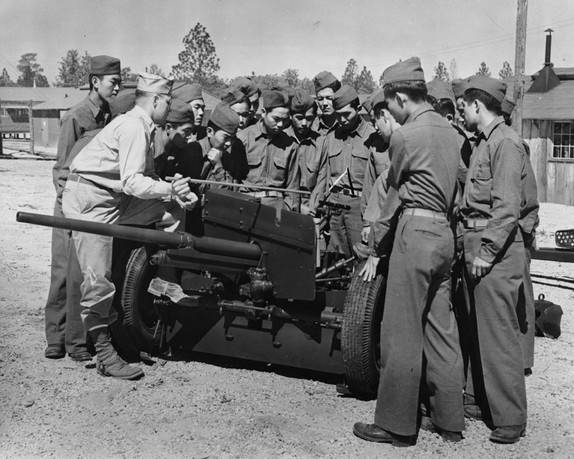
Although during the fighting in Italy and North Africa, the M3A1 guns showed themselves mediocre, they were quite effective against weakly protected Japanese tanks.
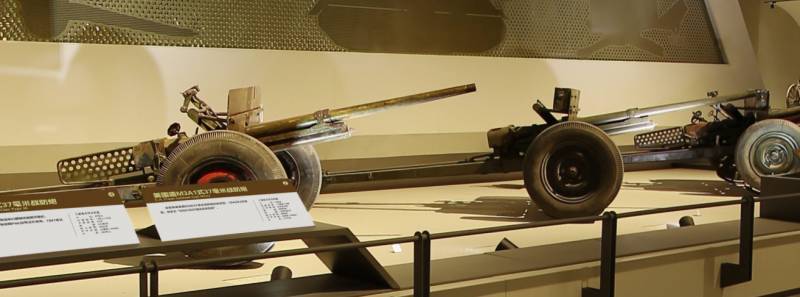
Initially, the fire from the M3A1 was carried out by an armor-piercing projectile weighing 0,87 kg with an initial speed of 870 m / s. At a distance of 450 m along the normal, it pierced 40 mm armor. Later, a projectile equipped with a ballistic tip with an increased muzzle velocity was adopted. Its armor penetration has increased to 53 mm. Also, the ammunition load included a 37-mm fragmentation projectile weighing 0,86 kg, containing 36 g of TNT. To repel infantry attacks, a grapeshot shot with 120 steel bullets could be used, effective at a distance of up to 300 m.
Until 1947, the Americans supplied the Kuomintang with approximately 300 37-mm anti-tank guns, which were used with varying success in hostilities with the Japanese. About a hundred of these weapons later went to the Chinese communists.
Captured Japanese 37 and 47 mm anti-tank guns
By the time the Sino-Japanese War began, the main Japanese anti-tank weapon was the 37-mm Type 94 cannon, which was put into service in 1936. Structurally, this gun was in many ways similar to the Type 37 11-mm infantry cannon, but more powerful ammunition was used for firing at armored vehicles.
An armor-piercing projectile weighing 645 g with an initial speed of 700 m / s at a distance of 450 m along the normal could penetrate 33 mm of armor. The mass of the gun in the combat position was 324 kg, in the transport position - 340 kg. Rate of fire - up to 20 rounds / min. Possessing relatively good data for its time, the 37-mm Type 94 cannon had an outdated design. The unsprung travel and wooden, iron-studded wheels did not allow it to be towed at high speed. Nevertheless, production of the Type 94 continued until 1943. More than 3 guns were produced in total.
In 1941, a modernized version of the anti-tank gun, known as Type 1, was adopted. The main difference was the barrel, which was extended to 1 mm, which made it possible to increase the muzzle velocity of the projectile to 850 m / s.
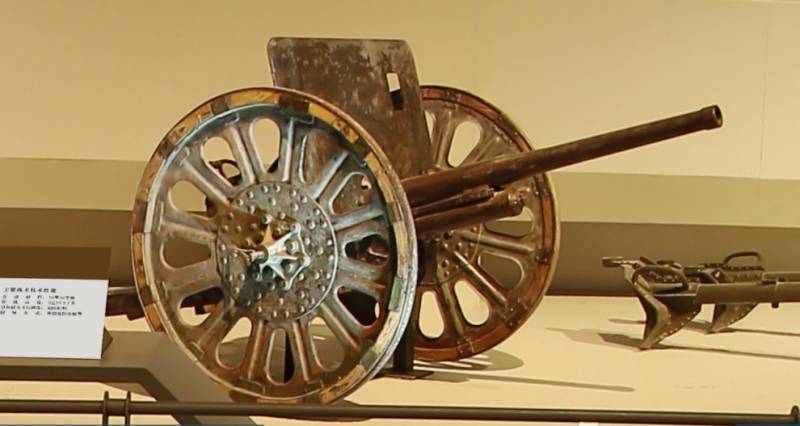
Japanese 37 mm Type 1 anti-tank gun at the Military Museum of the Chinese Revolution
Although the 37-mm Type 1 gun by the time it was put into service could no longer effectively deal with modern medium tanks, 1945 copies were produced by April 2.
Separate Japanese 37-mm anti-tank guns were occasionally captured by the Kuomintang and communist troops during the Sino-Japanese War. More than two hundred 37-mm cannons were at the disposal of the communists after the surrender of Japan. Captured guns were used in battles with the troops of the Kuomintang.
In connection with the projected increase in the protection of tanks in 1939, the 47-mm Type 1 anti-tank gun was adopted by the Imperial Japanese Army. The gun received a sprung suspension and wheels with rubber tires. This made it possible to provide towing with mechanical traction. Until August 1945, the Japanese industry managed to deliver about 2 300-mm Type 47 guns.
The mass of the 47-mm gun in the firing position was 754 kg. The muzzle velocity of 1,53 kg of an armor-piercing tracer projectile is 823 m / s. At a distance of 500 m, a projectile, when hit at a right angle, could penetrate 60 mm of armor. Compared to 37-mm shells, the 47-mm fragmentation shell weighing 1,40 kg contained much more explosive and was more effective when firing at manpower and light field fortifications.
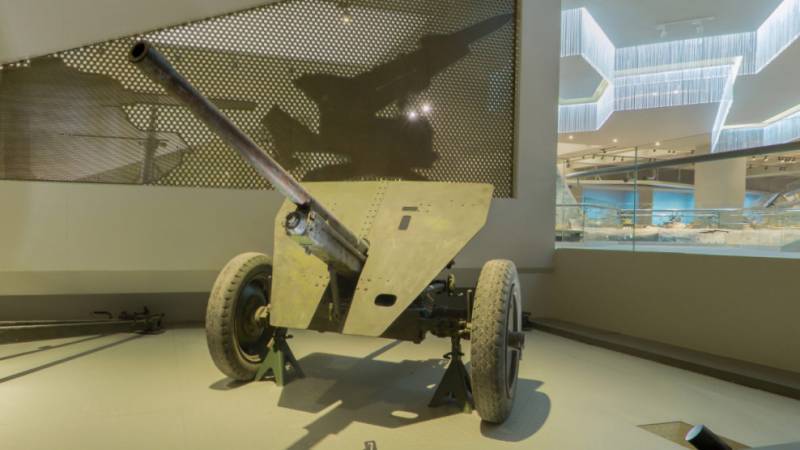
Japanese 47 mm Type 1 anti-tank gun at the Military Museum of the Chinese Revolution
For the late 1930s, the Type 1 gun met the requirements. However, in the course of hostilities it became clear that the frontal armor of the American medium tank "Sherman" could be penetrated at a distance of no more than 200 m.
After Japan's surrender, the Soviet Union handed over to the armed formations of the Chinese Communist Party a significant part of the equipment and weapons of the Kwantung Army. The exact number of Japanese anti-tank guns transferred to the USSR is unknown. Apparently, we can talk about several hundred guns. Captured 47-mm cannons were actively used by communist units against the Kuomintang and in the initial period of the Korean War.
Soviet 45 mm anti-tank guns
Within the framework of military-technical cooperation, the Soviet Union supplied several hundred 1937-mm anti-tank guns of the 1941 model and the 45 model to the Chinese government in the period from 1934 to 1937.
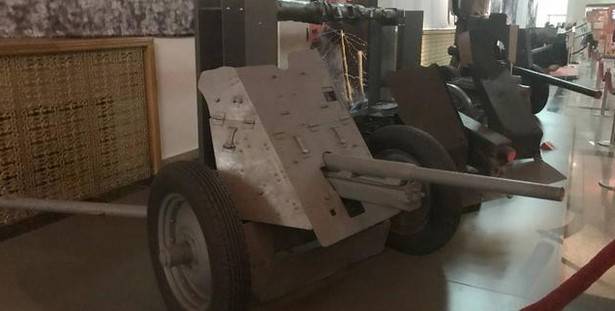
Soviet 45 mm anti-tank gun mod. 1937 at the War Museum of the Chinese Revolution
45-mm anti-tank guns mod. 1934 and arr. 1937 of the year lead their ancestry from the 37-mm gun of the 1930 model (1-K), which, in turn, was designed by engineers of the German company Rheinmetall-Borsig AG and had much in common with the 3,7 cm Pak 35/36 anti-tank gun.
The mass of the 45-mm gun mod. 1937 in a combat position was 560 kg, a calculation of five people could roll it a short distance to change position. Rate of fire - 15–20 shots / min. An armor-piercing projectile weighing 1,43 kg, leaving the barrel with an initial speed of 760 m / s, at a distance of 500 m along the normal could penetrate 43 mm of armor. The ammunition also included fragmentation and grape-shot shots. A fragmentation grenade weighing 2,14 kg contained 118 g of TNT and had a continuous zone of damage of 3-4 m.
Compared to the 37-mm Type 30 and 3,7 cm Pak 35/36 guns in the Chinese army, the Soviet 45-mm guns had a significant advantage in the fight against enemy manpower and could destroy light field fortifications. With acceptable weight and size characteristics, the armor penetration gun of 45 mm shells was more than enough to destroy any Japanese tanks that fought in China.
Combat use of Chinese anti-tank guns against Japanese tanks
During the years of the Japanese-Chinese armed confrontation, the Chinese anti-tank artillery did not have a significant impact on the course of hostilities.
This is primarily due to the incorrect use of existing anti-tank guns and a very poor level of preparation of the calculations. Most often, the available 37-45-mm guns were used for fire support of the infantry, and not for fighting armored vehicles. It was common practice to crush artillery batteries and use individual guns attached to infantry units. In the event that enemy tanks appeared on the battlefield, this did not allow concentrated fire of anti-tank guns on them, made it difficult to supply ammunition, service and repair.
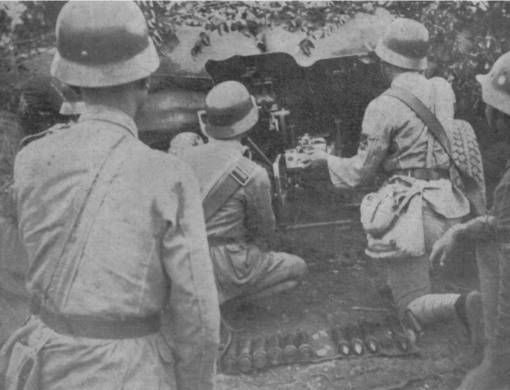
However, there have been exceptions.
So, in one of the first major battles of the Sino-Japanese War - in the battle for Wuhan (June - October 1938), the Chinese anti-tank artillery managed to knock out and destroy 17 armored vehicles.
Although there were relatively few tanks in the Japanese army, they did not differ in a high level of protection and powerful weapons, in most cases the Chinese were forced to use improvised anti-tank weapons against them. With a shortage of specialized anti-tank guns, the Chinese fired at Japanese tanks from field guns and howitzers. Also noted was the successful use of 20-mm anti-aircraft guns of German, Italian and Danish production.
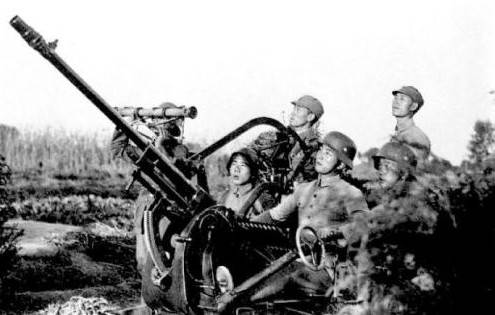
When the Chinese had the opportunity to prepare for defense, much attention was paid to engineering barriers: minefields were set up, rubble and anti-tank ditches were set up in tank-hazardous places on the roads, thick pointed logs were dug into the ground, connected by metal cables.
Most often, Chinese soldiers used Molotov cocktails and bundles of grenades to fight Japanese tanks. In battles with the Japanese, "live mines" were also used - volunteers, hung with grenades and explosives, who blew themselves up along with Japanese tanks. The most noticeable impact of "living mines" had on the course of the Battle of Taierzhuang in 1938.
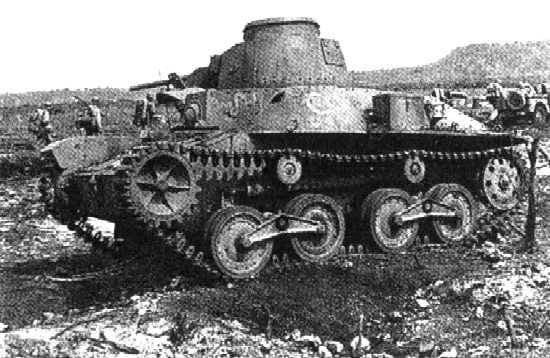
In the initial phase of the battle, a Chinese suicide bomber stopped a Japanese tank column by blowing himself up under the head tank. In one of the fiercest battles, the soldiers of the Chinese Death Corps blew up 4 Japanese tanks with them.
Relations between the Kuomintang and the Chinese Communist Party and the course of the civil war
Until a certain moment, the Kuomintang and the Chinese communists acted as a united front against the Japanese. But after the success of the 8th Army of the NRA, subordinate to the leadership of the Communist Party in the "Battle of one hundred regiments" that began on August 20, 1940 and ended on December 5 of the same year, Chiang Kai-shek, fearing an increase in the influence of the CPC, in January 1941 ordered an attack on the headquarters column of the newly formed communists of the 4th army. The communist troops, outnumbered by the attackers by about 7 times, were completely defeated.
Mao Zedong wanted to use this incident as an excuse to break the united anti-Japanese front. However, thanks to the position of the Soviet representatives, this was avoided. But relations between the parties were hopelessly ruined, and subsequently the Kuomintang and the Communist Party went over to open armed confrontation.
After Japan's surrender, the Kuomintang and the CCP were unable to control the entire territory of the country. Although the armed forces of the Kuomintang were larger and better equipped, they were mainly located in the west of the country, and the best divisions armed with American weapons were in India and Burma.
Under these conditions, Chiang Kai-shek, in exchange for guarantees of personal safety, took command of the troops of the former puppet government of Wang Jingwei and entrusted them with protecting the cities and communications left by the Japanese. They were ordered not to surrender to the communists and not to surrender their weapons. As a result, the communists were unable to occupy railway junctions and large cities. They controlled small and medium-sized cities, individual sections of railways and the surrounding countryside.
Despite the massive assistance from the Americans, the Kuomintang were unable to defeat the communist forces, relying on the support of the majority of the rural population. In many ways, this was facilitated by the position of the USSR.
After the liberation of Manchuria from the Japanese invaders, the Soviet government decided to transfer Manchuria into the hands of the Chinese communists. Before the withdrawal of Soviet troops from Manchuria, the Kuomintang government was going to transfer its troops there, which were to occupy the liberated regions. But Moscow did not allow the use of Port Arthur and Dalny for the transfer of Kuomintang troops, as well as vehicles of the China-Changchun Railway - the former CER, and did not allow the creation of military formations and police forces from among the Kuomintang in Manchuria.
After the surrender of Japan, the main forces of the Chinese communists were dispersed over the nineteen "liberated regions." In northern China, Qinhuangdao, Shanhaiguan and Zhangjiakou fell under their control. These territories were in contact with the regions of Inner Mongolia and Manchuria, liberated by the Soviet Army, which facilitated the material and technical supply and the transfer of troops. At the first stage, the communists transferred about 100 thousand people to the northeast, and by November 1945 the entire territory of Manchuria north of the Songhua River was occupied by the CPC troops.
In October 1945, the Kuomintang troops went over to offensive actions, the purpose of which was to seize the railway leading from the south to Beijing, clearing the Beijing-Tianjin region and Manchuria. Chiang Kai-shek's troops in 1946-1949 received military aid from the United States in the amount of $ 4,43 billion, and at first they managed to seriously squeeze the communists out. However, subsequently, military luck turned away from the nationalists.
The communists took advantage of the fact that cities with developed industries, the military property of the surrendered Kwantung Army, as well as vast rural areas were in their hands. Thanks to the land reform carried out, the CCP attracted the peasantry to its side, as a result of which ideologically motivated recruits began to come to the communist army. At the existing industrial enterprises, it was possible to organize the production of ammunition for small arms and artillery. The Soviet Union handed over the captured Japanese military equipment.
As a result, the Manchu grouping became the strongest in the army of the Communist Party, artillery and even tank units began to be created in it. In 1947, the communist forces managed to liberate a number of large areas, and the entire Shandong province came under the control of the communists. In the fall of 1948, the Liaoshen battle unfolded, as a result of which a half-million group of Kuomintang troops was destroyed. The balance of forces changed dramatically in favor of the Communists, and a turning point occurred in the course of hostilities.
After the Nanjing government ignored the terms of the communist peace agreement, the three CCP field armies went on the offensive and crossed the Yangtze. In one day, under artillery and mortar fire, under air strikes, 830 thousand soldiers with weapons, ammunition and equipment were transferred to the southern bank of the widest river in China. On April 23, 1949, the Kuomintang leadership left Nanjing and moved to Guangzhou, while Chiang Kai-shek himself flew to Taiwan.
By mid-April 1949, the Kuomintang army was cut into pieces. One group defended the Shanghai-Nanjing region, the other - the border between the Shaanxi and Sichuan provinces, the third - covered access to the Gansu, Ningxia and Xinjiang provinces, the fourth - the Wuhan region, the fifth - by order of Chiang Kai-shek, was evacuated to Taiwan. On May 11, communist troops stormed Wuhan. Then they moved to Shanghai, and on May 25 the city was taken. In early May, Taiyuan and Xian fell, and the southern part of Shaanxi province was cleared of the Kuomintang. Lanzhou (center of Gansu province) was occupied on August 25, and Xining (center of Qinghai) on September 5.
On October 1, 1949, the People's Republic of China was proclaimed in Beijing, but fighting continued in the southern part of the country.
On October 8, communist troops broke into Guangzhou and reached Hong Kong. In early November, the Communists, in pursuit of the retreating Kuomintang, captured the provinces of Sichuan and Guizhou. Shortly before this, the Kuomintang government was evacuated to Taiwan by American planes.
In December 1949, Chiang Kai-shek's group of troops in Yunnan capitulated. Tens of thousands of disorganized Kuomintang soldiers and officers fled in disarray to Burma and French Indochina. Subsequently, about 25 thousand Kuomintang members were interned by the French colonial administration. At the end of December 1949, Chengdu was taken by the communists. In October 1949, the communist troops entered Xinjiang unopposed. In the spring of 1950, the island of Hainan was taken under control. In the fall of 1950, PLA units entered Tibet, and on May 23, 1951, the "Agreement for the Peaceful Liberation of Tibet" was signed.
Armored vehicles used in the civil war
Taking into account local conditions, dirt roads and weak bridges, light armored vehicles were mainly used in the hostilities between the Kuomintang and the CPC.
By the beginning of the civil war, delivered in the second half of the 1930s, German tanks Pz.Kpfw.I, Soviet T-26 and BA-6 armored vehicles were destroyed in battles or out of order due to breakdowns. The same fate befell the Renault FT-17 tanks purchased in France and Poland. However, in the Kuomintang troops in 1946, there were several armored vehicles of German production Kfz. 221 and Sd.Kfz. 222.
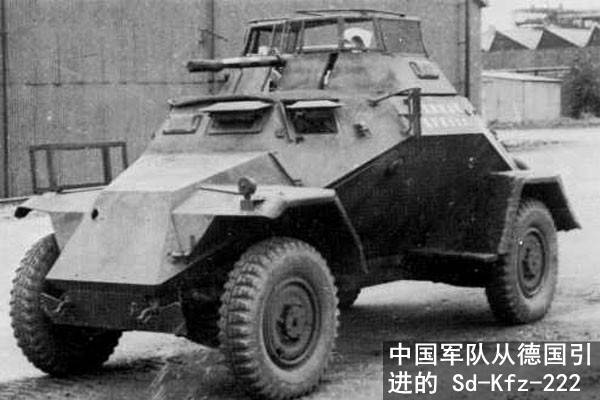
For its time, it was a very advanced armored vehicle that could be used for reconnaissance and fighting light armored vehicles. Combat weight Sd.Kfz. 222 was 4,8 tons. Frontal armor - 14,5 mm, side armor - 8 mm. Armament - 20 mm automatic cannon and 7,92 mm machine gun. Crew - 3 people. Highway speed - up to 80 km / h.
The Kuomintang troops had several dozen American-made M3A1 armored vehicles, which were used for reconnaissance, patrolling, in the role of light tractors and armored personnel carriers.
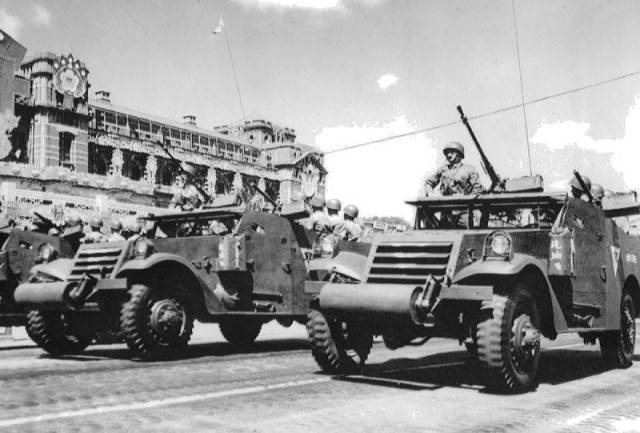
M3A1 armored vehicles at the parade of the Kuomintang troops
The mass of the armored car in the combat position was 5,65 tons. The front of the hull was protected by 13 mm armor, the side - 6 mm. Armament - 12,7 mm M2 machine gun, and 1-2 7,62 mm machine guns. Highway speed - up to 80 km / h. Inside could accommodate 5-7 paratroopers.
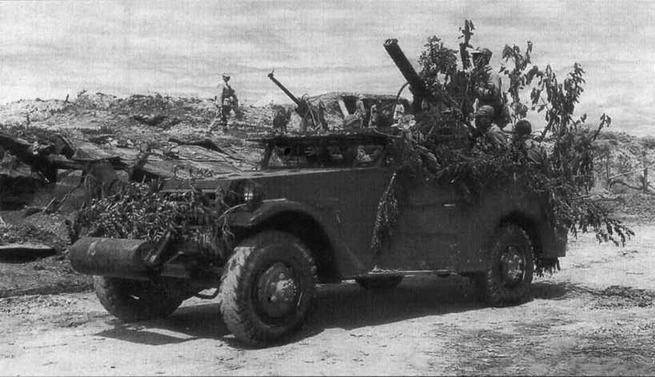
Kuomintang armored car M3A1 is equipped with a 7,62-mm Browning M1919A4 machine gun and a 12,7-mm Browning machine gun with water cooling
Also at the disposal of the Chinese nationalists were a number of M3 half-track armored personnel carriers.
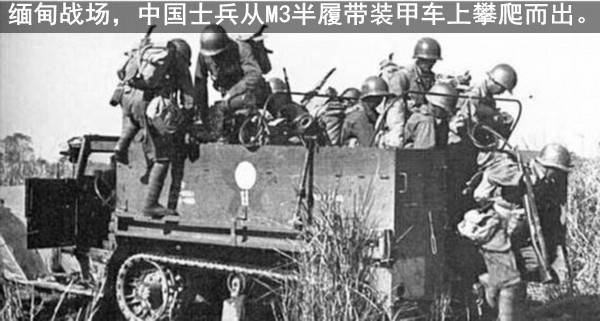
This vehicle weighing 9,1 tons was protected and armed in the same way as the M3 wheeled armored car, and could carry 13 people at speeds up to 72 km / h.
The most protected and heavily armed tank in the Kuomintang troops was the M4A2 Sherman. After the withdrawal of the American Marines from Tianjin in 1947, six medium tanks were transferred to the 74th Nationalist Division. Prior to this, the Chinese fought in India on M4A4 tanks, but tanks of this modification did not participate in battles with the communists.
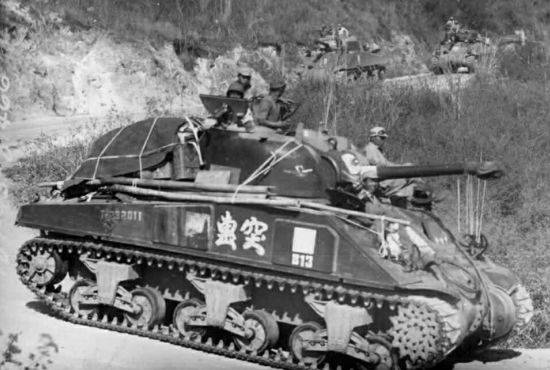
The M4A2 tank weighed 30,9 tons and was protected by 64 mm frontal armor. The thickness of the side and stern armor was 38 mm. Armament - 75 mm M3 cannon and two 7,62 mm machine guns. The maximum speed is 42 km / h. Crew - 5 people.
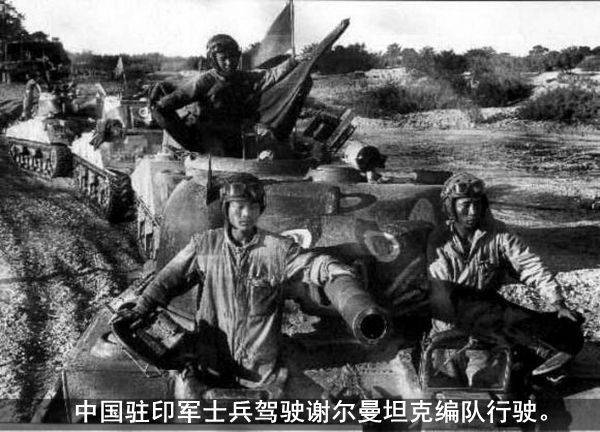
The Shermans handed over to Chiang Kai-shek's troops did not have much influence on the course of hostilities. After the defeat of the 74th Division, at least one tank was captured by the communists and subsequently took part in the victory parade in Xuzhou.
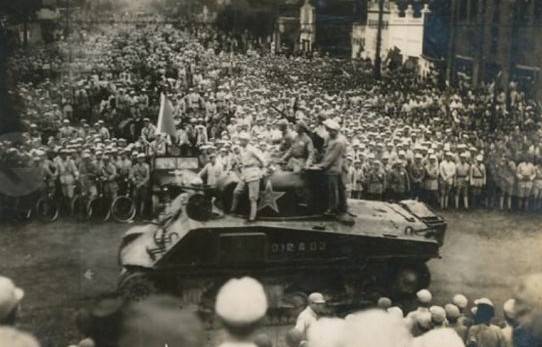
The main striking force in the armored units of the Kuomintang was the M3A3 Stuart light tanks, of which more than 100 units were delivered.
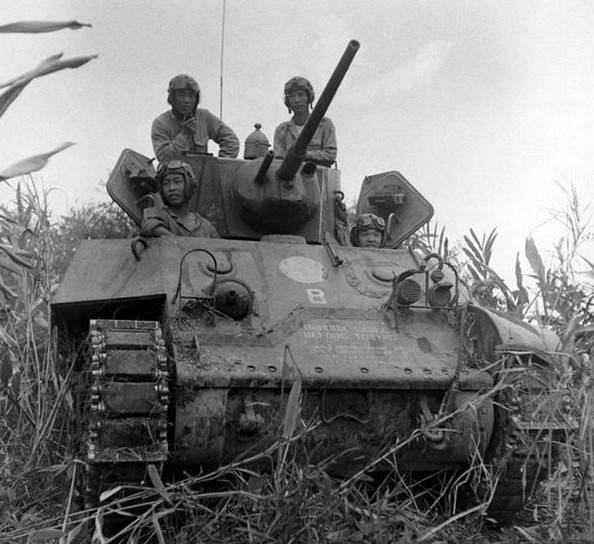
For a light tank weighing 12,7 tons, the Stuart was well protected and had upper frontal armor 25–44 mm thick, which provided protection against 20–25 mm shells. The side and stern 25 mm armor could withstand hits from large-caliber bullets and 20-mm shells. The thickness of the frontal armor of the turret is 38–51 mm, the side and stern armor is 32 mm. The 37-mm M6 cannon provided an armor-piercing projectile weighing 870 g with an initial velocity of 884 m / s. At a distance of 300 m, the M51 Shot armor-piercing tracer round penetrated 43 mm armor along the normal. To combat the infantry, there were three rifle-caliber machine guns. Carbureted engine with a capacity of 250 liters. with. could accelerate a tank to 60 km / h.
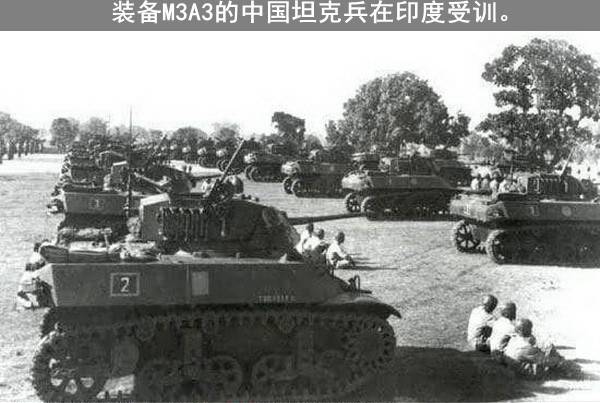
The M3A3 Stuart tank was well suited for the specific conditions of the Chinese civil war. It had good cross-country ability, was sufficiently mastered by Chinese tankers and was popular among the troops.
At the same time, the 37-mm projectile had a very weak fragmentation effect, which made it ineffective to fire at manpower and field fortifications. The Stuart's main defense against artillery fire was its high mobility.
In the second half of the 1930s, the Kuomintang government purchased 100 CV33 tankettes from Italy. These cars were built by Fiat and Ansaldo.
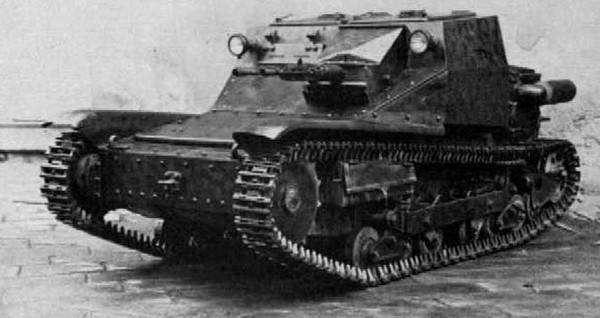
Wedge Heel CV33
Initially, the CV33 was armed with a 6,5mm Fiat Mod. 14 machine gun, but in China the vehicles were rearmed with Japanese 7,7mm machine guns. The thickness of the frontal armor of the hull and wheelhouse was 15 mm, the side and stern were 9 mm. With a mass of 3,5 tons, a tankette equipped with a 43 hp carburetor engine. sec., could accelerate to 42 km / h.
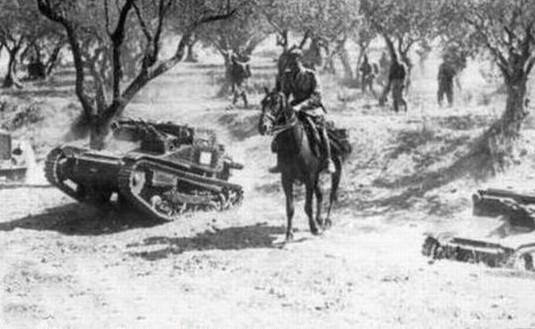
In the Chinese army, CV33 tankettes were mainly used for communications and reconnaissance, including as part of cavalry units. After the high vulnerability of the tankettes was revealed in a clash with the Imperial Japanese Army, some of the vehicles were used as tractors for the German 3,7 cm Pak 35/3 anti-tank guns. As such, they took part in the civil war, and were subsequently captured by the PLA.
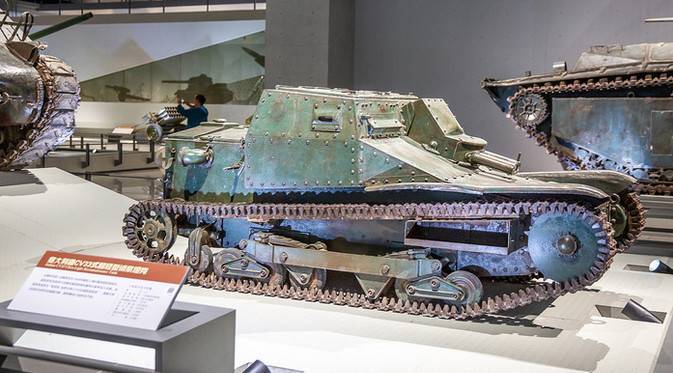
Wedge heel CV33 at the Military Museum of the Chinese Revolution
The armored forces of the Kuomintang army had up to two dozen American amphibious tanks LVT (A) 1 and LVT (A) 4. These vehicles have bulletproof armor and a weight of 15-16 tons. The maximum speed on land is 32 km / h, on water - 12 km / h. The LVT (A) 1 has a turret from the M5 Stuart tank with a 37 mm gun and a 7,62 mm machine gun. The LVT (A) 4 is armed with a 75mm howitzer, 7,62 and 12,7mm machine guns.
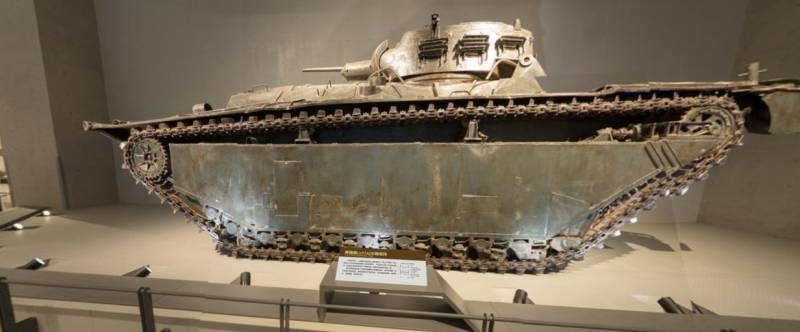
Floating tank LVT (A) 1 at the War Museum of the Chinese Revolution
These seemingly clumsy vehicles, when used correctly, could be a very useful fire support tool in crossing water obstacles. However, there is no information about their combat use by the Kuomintang. Tracked amphibians were abandoned during the retreat, subsequently restored and used in the PLA until the mid-1970s.
If the Kuomintang army was mainly equipped with American-made armored vehicles, then the armed forces of the Chinese communists used captured samples. The armored divisions of the CPC mainly operated Japanese tanks transferred to the USSR (the Red Army captured 389 Japanese tanks), recaptured from the imperial army in battle or captured at tank repair enterprises.
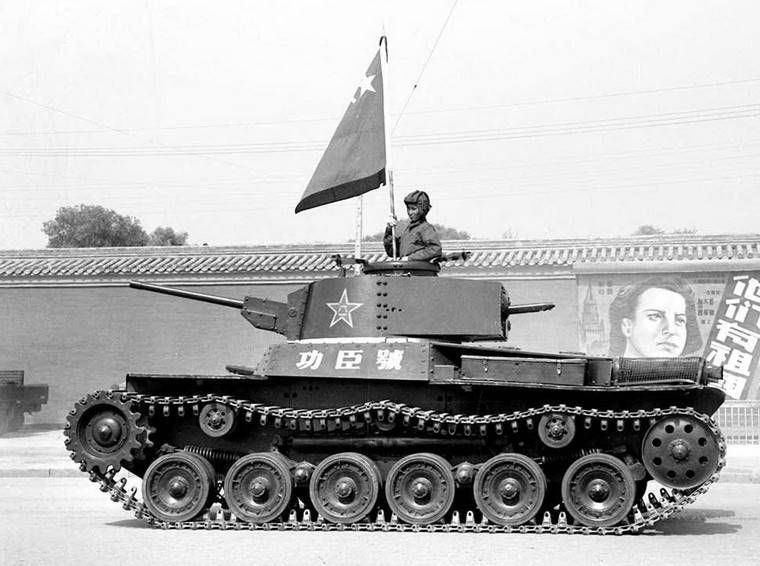
Tank Type 97, used by the Chinese communists
The most numerous were the Type 97 Japanese medium tanks.
The combat weight of the tank was 15,8 tons. In terms of the level of security, it approximately corresponded to the Soviet BT-7. The upper part of the Type 97 front plate is 27 mm thick, the middle part is 20 mm, and the lower part is 27 mm. Side armor - 20 mm. Tower and stern - 25 mm. The tank was armed with a 57mm or 47mm cannon and two 7,7mm machine guns. Diesel with a capacity of 170 liters. with. allowed to develop a speed of 38 km / h on the highway. Crew - 4 people.
The Chinese mainly exploited the latest modification with a 47 mm cannon. Despite the smaller caliber, due to the high initial velocity of the projectile, the 47 mm gun significantly surpassed the 57 mm gun in terms of armor penetration.
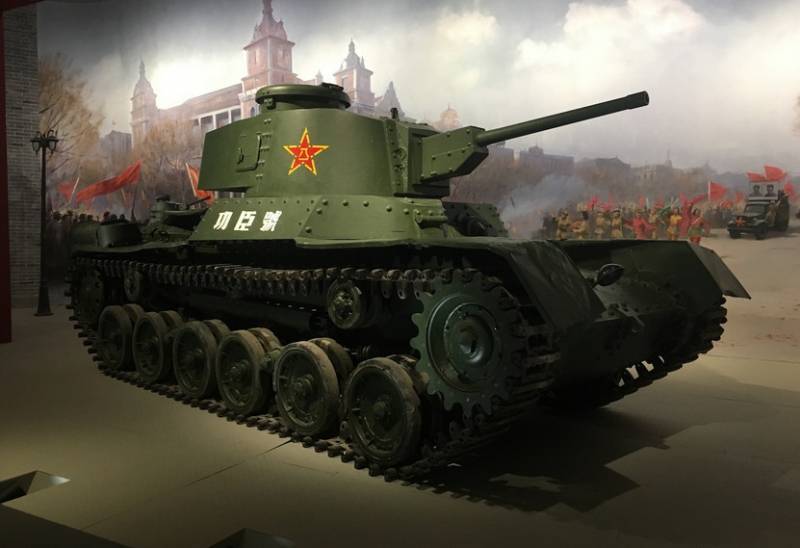
Tank Type 97 at the Military Museum of the Chinese Revolution
Among the exhibits of the Beijing Military Museum of the Chinese Revolution is a Type 97 tank with a 47-mm cannon.
According to the official Chinese stories, this is the very first tank used by the communist forces led by Mao Zedong. This combat vehicle was captured at a Japanese tank repair enterprise in Shenyang in November 1945. After repairs, the tank took part in the battles in Jiangnan, Jinzhou and Tianjin. During the battles for Jinzhou in 1948, the tank crew under the command of Dong Life broke through the defenses of the Kuomintang troops.
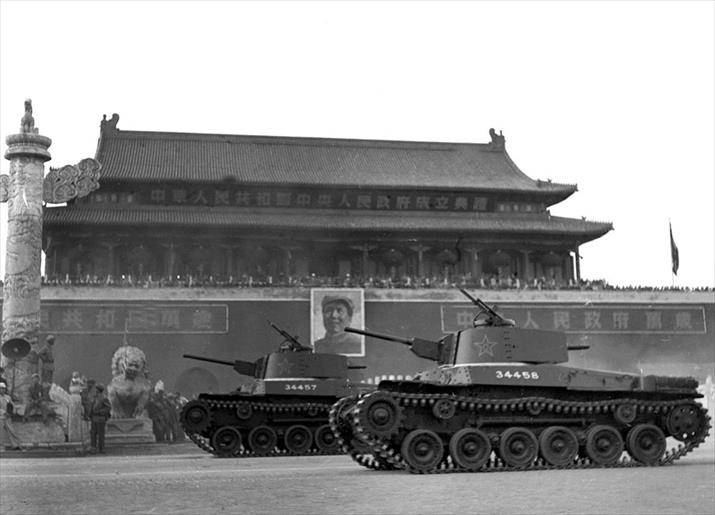
In 1949, this "hero tank" took part in the military parade dedicated to the founding of the PRC, and remained in service until the end of the 1950s.
The Chinese communists also exploited captured Japanese Type 94 tankettes. This vehicle, armed with a 7,7 mm machine gun, was used for reconnaissance, patrolling and as a tractor for anti-tank and field guns.
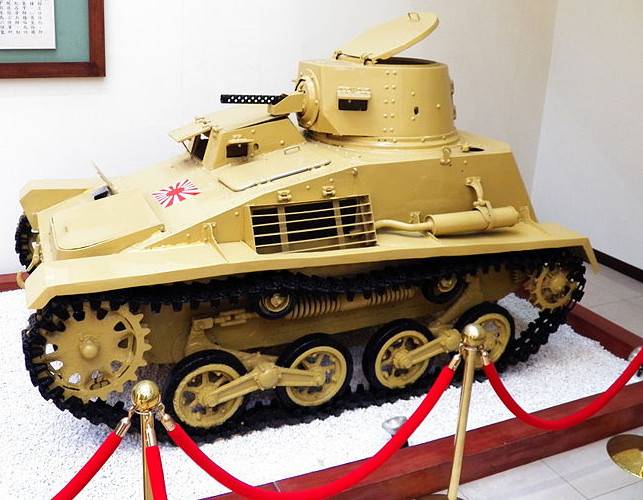
Japanese wedge Type 94
The mass of the vehicle was 3,5 tons. The thickness of the frontal armor and the machine gun mask was 12 mm, the stern sheet was 10 mm, the walls of the turret and the sides of the hull were 8 mm. Crew - 2 people. Carburetor engine with a capacity of 32 liters. with. accelerated the car on the highway to 40 km / h.
The Chinese communists also managed to capture a very rare sample - the Type 95 tracked motorized tires, which had the ability to move both by rail and by ordinary roads. The lifting and lowering of the moving elements of the tracked chassis on this machine was carried out using jacks. The transition from tracks to wheels took 3 minutes, and in the reverse order, much faster - 1 minute.
6 people could fit inside the motorcycle tires. Frontal armor - 8 mm, side armor - 6 mm. Armament - 7,7 mm machine gun. The maximum speed on the railroad is 70 km / h, on the highway - 30 km / h.
Among the trophies captured by the communist forces were several American-made M3A3 Stuart light tanks.
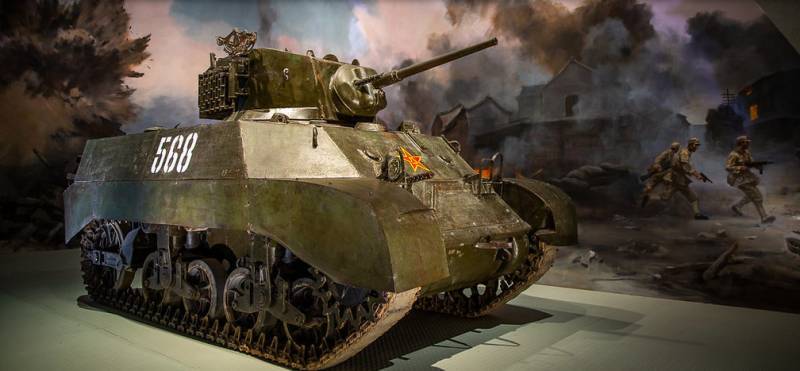
Light tank M3A3 Stuart at the Military Museum of the Chinese Revolution
Tank "Stuart" with hull number "568" was recaptured from the Chiang Kai-shekists during the battles for South Shandong in January 1947. Later, this M3A3 entered the tank forces of the East China Field Army, and it participated in the Jinan and Huaihai campaigns. During the Battle of Jinan, the tank crew under the leadership of Shen Xu played an important role. After the end of the battle, "Stuart" received the honorary title "Meritorious Tank", and the tank commander Shen Xu - "Iron Man Hero". In 1959, this tank was transferred from Tank Academy No. 1 to the Military Museum of the Chinese Revolution in Beijing.
Use of anti-tank artillery in civil war
Taking into account the specifics of the civil war in China, infantry, machine guns and artillery played the main role on the battlefield. At the first stage of hostilities, the Kuomintang possessed a significant numerical superiority in armored vehicles, and therefore the communist forces had to organize anti-tank defense.
37, 45 and 47-mm anti-tank guns could penetrate the frontal armor of all the tanks on the opposing sides, with the exception of the few Shermans transferred to the nationalists by the Americans. In these conditions, much depended on the qualifications of the tank crews. The key to invulnerability and successful actions on the battlefield was competent maneuvering and the ability to use the terrain. In most cases, the calculations of the Chinese anti-tank guns turned out to be unable to effectively shoot at fast moving and firing tanks on the move. In fairness, it should be said that there were few well-trained tankers among the Chinese.
Taking into account the area of the territory in which the hostilities were conducted, and the relatively small number of tanks and specialized anti-tank guns available in the Kuomintang and Communist troops, the main threat to armored vehicles was represented by mine-explosive obstacles and anti-tank infantry weapons: bazookas, hand grenades and bottles with an incendiary mixture. It was they, as well as the poor training of the Chinese crews, who were unable to maintain the equipment in working order, that caused the main losses. Some tanks, stuck in the rice fields and abandoned by the crews, changed hands several times.
To be continued ...
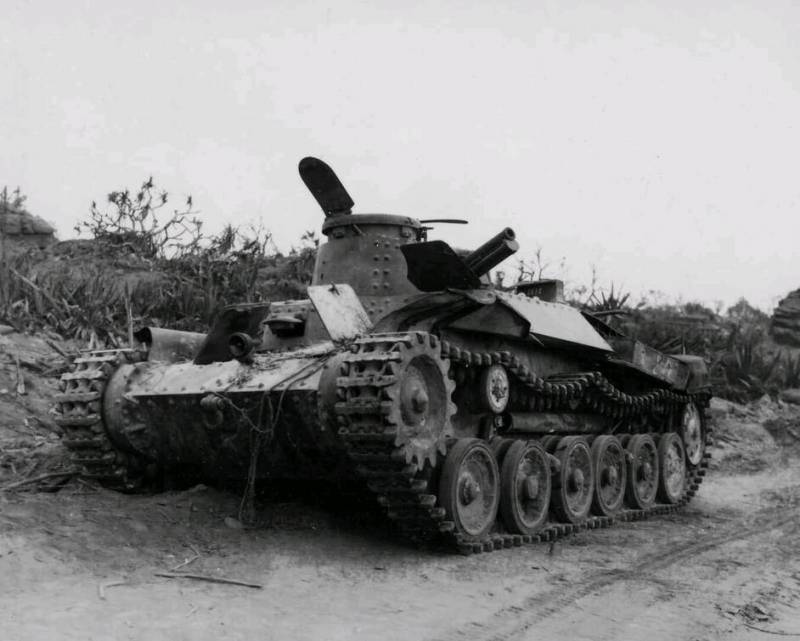
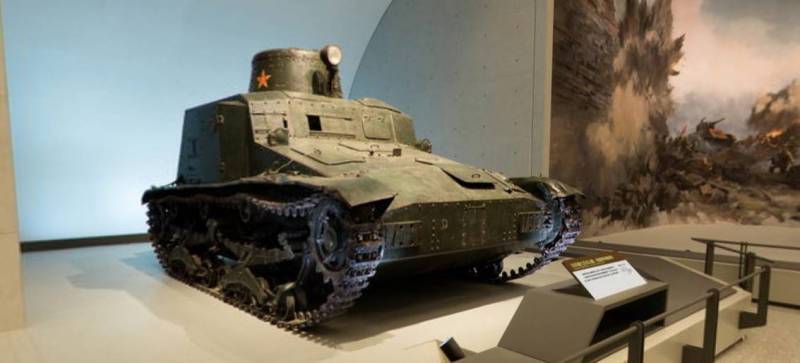
Information